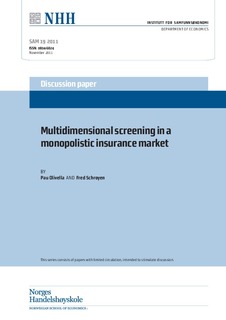| dc.contributor.author | Olivella, Pau | |
| dc.contributor.author | Schroyen, Fred | |
| dc.date.accessioned | 2012-03-13T12:24:18Z | |
| dc.date.available | 2012-03-13T12:24:18Z | |
| dc.date.issued | 2011-11 | |
| dc.identifier.issn | 0804-6824 | |
| dc.identifier.uri | http://hdl.handle.net/11250/163360 | |
| dc.description.abstract | In this paper, we consider a population of individuals who differ
in two dimensions: their risk type (expected loss) and their risk aversion.
We solve for the profit maximizing menu of contracts that a monopolistic
insurer puts out on the market. First, we find that it is never optimal
to fully separate all the types. Second, if heterogeneity in risk aversion is
sufficiently high, then some high-risk individuals (the risk-tolerant ones) will
obtain lower coverage than some low-risk individuals (the risk-averse ones).
Third, we show that when the average man and woman differ only in risk
aversion, gender discrimination may lead to a Pareto improvement. | no_NO |
| dc.language.iso | eng | no_NO |
| dc.publisher | Norwegian School of Economics, Department of Economics | no_NO |
| dc.relation.ispartofseries | Discussion Papers;19/2011 | |
| dc.subject | insurance markets | no_NO |
| dc.subject | asymmetric information | no_NO |
| dc.subject | screening | no_NO |
| dc.subject | gender discrimination | no_NO |
| dc.subject | positive correlation test | no_NO |
| dc.title | Multidimensional screening in a monopolistic insurance market | no_NO |
| dc.type | Working paper | no_NO |
| dc.subject.nsi | VDP::Social science: 200::Economics: 210::Economics: 212 | no_NO |
